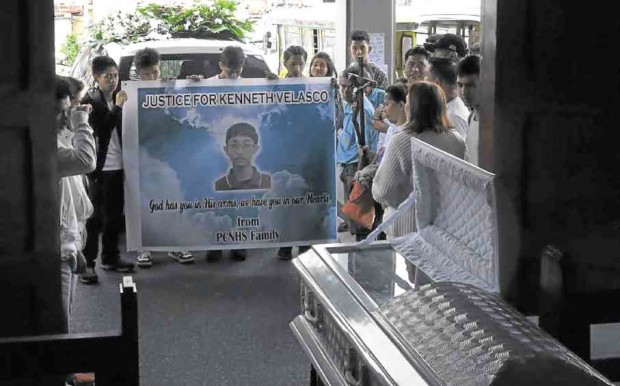
Relatives and classmates of Kenneth Velasco attend his burial in Baguio City. —EV ESPIRITU / INQUIRER FILE PHOTO
BAGUIO CITY—A 16-year-old boy has been linked to the death of a high school student who was stabbed 40 times while on his way to school in December.
The city prosecutor’s office is reviewing the evidence in connection with the Dec. 13 attack on Kenneth Velasco, 16, but has not released details about the suspect “because of his age,” Senior Supt. Ramil Saculles, Baguio police chief, said on Tuesday.
Saculles spoke about the case after attending a hearing on the fate of a walkway, known among students as “Labsan,” where Velasco was found dead, and the security of other areas used by students.
Saculles said teams from the city police were tasked to get witnesses’ testimonies to strengthen the case against the suspect, who may have attacked Velasco because of a grudge.
It could also have been robbery, Saculles said, because Velasco’s money and computer tablet were missing.
Saculles turned to the city council for legislation to “remove … opportunities for criminals,” beginning with the closure of narrow, unlighted and unmonitored walkways where crimes happen.
Velasco was stabbed on the walkway shortly before 7 a.m. on Dec. 13 on his way to school, a block away from City Hall.
The walkway is badly maintained. It is covered with a canopy but only its frames remain. The area is littered with trash and owners of houses and buildings along the walkway have covered their windows with iron sheets.
“We have to protect our windows because when fights erupt [along the staircase] the windows get stoned,” a resident told the council during the hearing.
The council was asked to either close the walkway or outfit it with lighting fixtures and closed-circuit television cameras.
The law bars the city government to close any road right of way, which may include walkways, said city engineer Nazita Bañez. But the city government needs to introduce solutions in its crime prevention programs beginning with an inventory of alleys and walkways, she said.
“There are three elements of crime—intent, means and opportunity,” Saculles told the council.
“Criminals would plan to commit a crime and may have the capacity but we should have control over opportunity. If we remove opportunity, then criminals would [fail] to commit crimes,” he said. —VINCENT CABREZA